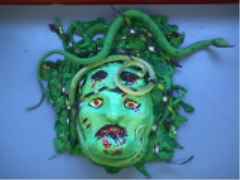 |
“MONSTERS
& MYTHS: SCULPTS” MYTHOLOGY CREATURES By Lori Langsner, Art Teacher |
AIMS:
1.
Students will create a plaster craft (papier-mâché) sculpture to depict
mythological creatures.
2.
Students will explore myths from many lands, Greek, Egyptian, Roman and
Japanese.
3.
Students will create symbolism and three-dimensionality in their sculptures by
adding collage materials to depict various associations. (Unicorn - one horn,
Cyclops - one eye, Medusa - snakes, Minotaur - bull/man)
DO NOW: Describe some words or phrases you would associate with each of the following mythological creatures:
KAPPA
(Japanese): - head of a monkey, body of a tortoise, limbs lined with scales. If treated with courtesy, this river dwelling creature is
harmless, if ill-treated; it will prey on humans.
SPHINX (Egyptian): -
creature with the body of a lion and the face of a man stands guard over the
Great Pyramid. Riddle: “What animal is that which in the morning goes on
all fours, at noon on two, and in the evening upon three? (“Man, who in
childhood creeps on hands and knees, in manhood walks erect, and in old age with
the aid of a staff.”)
UNICORN
(Roman): -
described as a ferocious beast, similar to a horse, with the head of a deer,
feet of an elephant, tail of a boar, deep bellowing voice and a single black
horn standing out from the middle of its forehead. However, it was later
discovered to be a great lover of purity and innocence.
MINOTAUR
(Greek): half bull, half
man, and the most fearsome monster of ancient times. His horns were as sharp as
knives, his great hoofs could kick the life out of the strongest of heroes, its
food was human flesh, and lived in a labyrinth.
VOCABULARY:
1.
mythology
- stories meant to give meaning to all life occurrences
2. sculpture - a three
dimensional form
3. plaster craft - gauze
impregnated with plaster used for molding
4. papier-mâché - an art medium of torn paper and past
5. “additive” sculpture –
begin with a base and “add” to create dimensionality
GRADE
LEVEL:
6-8
SETTING:
art classroom
TIME
ALLOWANCE:
6 weeks (class meets 4x per week for 40 minutes)
INTERDISCIPLINARY AREAS: Language Arts, History
HOMEWORK: Using computer technology, research mythological creatures and gather resource information to help you sketch ideas for the creation of your own mythological creature.
MATERIALS: newspaper, plaster craft, found objects and collage materials; branches, twigs, yarn, raffia, ribbon, rubber noses, plastic fingernails, and pre-molded plastic masks, cardboard rolls, bottle caps, tempera and metallic paints, poster board, scissors, glue, hot glue gun, stapler, paintbrushes, water cups, palettes, newspaper, hole punch, gloss medium, glitter paints, sparkles
MOTIVATION:
Language Arts class study of myths from many lands. Homework web sites on
mythological creatures will be reviewed and discussed in class, following a
visit to our school library where we will explore and share our newly found
World Wide Web explorations.
INTERNET LINKS:
http://members.tripod.com/~angelas98/creatures.html
– Greek & Roman Mythological Creatures
http://library.thinkquest.org/13238/index.htm - Classical Mythology
http://myth.com
(under construction - available late Dec. 2000) - Mythology & Folklore
PROCEDURE:
1.
Students will brainstorm associations and phrases for various mythological
creatures. (Medusa: hideous monster, ugly, scary, venom-like, Minotaur: horns
have the sharpness of a silver sword, Unicorn: fantastical, magical, beautiful,
loving)
2.
Students will contemplate the myth they like best and why and decide what
materials would best express their creature.
3.
Students will sketch and color their mythological creatures.
4. Using co-operative learning skills, students will work in groups of 2 - 4 to create plaster sculptures:
|
a) Coat plastic mask with Vaseline or create cardboard and paper base. b)
Cut gauze into 2” wide by 6” strips. c) Cover plastic mask or base
by overlapping each strip and repeating 3 times in varying direction. d) Allow drying for 10
minutes, gently removing plaster from plastic mask and allowing drying on
newspaper overnight. |
Each group will continue the
process until all is complete.
5. Once dry, sculptures are then sanded, painted, and decorated to illustrate the mythology creatures
6. Fine details may be added, as
well as, collage materials to further enhance and exaggerate the mythological
theme.
7. Completed sculptures will be
displayed in classroom for evaluation and critique.
8. Students will set up a
showcase display in school hallway for entire school population to view.
EVALUATION:
1.
Retell the story of different myths you have studied for this project.
2. How are our sculpture
similar/different to the pictures you have seen in your readings and web
explorations?
3. Describe how you created your
mythological creature.
4. Why are our “creatures” an
example of “additive” sculpture?
5.
Which mythology creatures do you like best?
Why?
ATTACHMENTS:
Digital images of students and mythological creature sculptures (see link at bottom of page)
FOLLOW-UP ACTIVITIES:
1. Language Arts class will use sculptures as props in class presentation of myths (Link to Ms. Shea’s lesson: Monsters & Myths)
2. Invite creative writing classes to view our exhibit and respond to our sculptures by writing their own myths.
3.
Have other classes create paper masks, papier-mâché masks, and clay masks of
mythological creatures.
4.
Visit Museums to view their cultural mask and sculpture collections.
5.
Create student web pages of mythological creations.
6.
Produce a book illustrating this interdisciplinary project – (CHAPBOOKS.COM
– classroom and community publishing – www.chapbooks.com
MYTHOLOGY CREATURES:
2. Minotaur
3. Unicorn
4. Cyclops
5. Mermaid
6. Sphinx
ENRICHMENT:
Music
playing as students are working on “The Unicorn”
Ask each group to sketch a
mythological creature that they make up and then present to the class
DIGITAL IMAGES:
![]() Click
here to see photo album of students at work and final projects
Click
here to see photo album of students at work and final projects